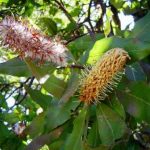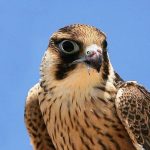TREE LIFE
December 1985
MASHONALAND CALENDAR
Tuesday December 3rd: Botanic Garden Walk
Saturday December 7th: ANNUAL TREE PLANTING CEREMONY AT MUKUVISI WOODLANDS. The Mukuvisi Woodland Association have invited us to plant a tree at the Woodlands commencing at 0930 hours. We would therefore welcome as many members as possible to join us on this occasion, the kiosk will be open to serve soft drinks and ice cream, but the tea will be on the house. See you there!
Sunday December 8th: Social gathering at Meg Coates Palgrave’s house, 42 Kariba Crescent, Hillside, phone 84419. We will meet at about 10 for tea and then those that wish may stroll around Mukuvisi Woodland where Meg has much to show us. Bring along your lunch, for afterwards Meg offers a tree time quiz, one that she and Paul drew up and tucked away for a rainy day. See you there.
MATABELELAND CALENDAR
Sunday December 1st: Hillside Dams again, this time to the lower dam area. Meet at 0830 hours at the Aloe Garden Car Park.
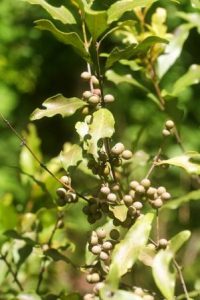
Euclea divinorum. Photo: Bart Wursten. Source: Flora of Zimbabwe
On Sunday 3 November we went to the Upper Dam area Hillside Dams, at the end of Sable/Impala Roads. There was a little water in the dam, due no doubt to the recent rain, and it was pleasantly soft underfoot. A good few trees were in leaf, and we identified some 50, including 4 Acacias, Acacia galpinii, A. gerrardii, A. karroo and A. rehmanniana; Albizia amara still flowering, for their flowers have lasted unusually long this year; Aloe excelsa; Azanza garckeana; many Burkea africana were flowering; Carissa edulis; Catha edulis; Combretum hereroense in flower and shiny new leaf, with a few old fruits; Combretum molle; Commiphora mollis, Commiphora schimperi; Cussonia natalensis flowering; Diplorhynchus condylocarpon flowering; Dombeya rotundifolia with remains of bronzed flowers still persisting; Dovyalis zeyheri; Ehretia rigida; Erythrina latissima; a few Euclea divinorum; many E. natalensis; Euphorbia ingens; Faurea saligna; Ficus ingens; F. glumosa; F. natalensis, and a smaller leaved fig, with a shortish petiole. We certainly look forward to a clarification of the smaller leaved fig; Grewia monticola; Lannea discolor; Maytenus senegalensis, one of which, having flowered heavily, apparently had all flowers killed by heat; Osyris lanceolata; Ozoroa insignis subsp. reticulata flowering; Peltophorum africanum with well-developed fruit; Pseudolachnostylis some flowering, and some with large well developed fruit; Pterocarpus angolensis fruiting; Rhoicissus tridentata; Rhus pyroides; Rhus tenuipes; Schrebera alata; Sclerocarya birrea; Strychnos spinosa; Tetradenia brevispicata; Terminalia sericea; Ximenia caffra.
-C. Sykes
BOTANIC GARDEN WALK: 5TH NOVEMBER 1985
As Tom Muller was attending the National Conservation Strategy Conference, we looked at the figs once again, because the Ficus sycomorus on the lawns were alive with wasp activity. The wasps on one tree were ready to emerge and so opening up the figs released a multitude of females and a few shy males that preferred to hide in the darker recesses. The range of species was fascinating with a number of the long-ovipositor wasps with an iridescent green body. On a different tree we found hundreds of these long-ovipositor females reversing on their tails and telescoping their ovipositor into the fig wall, thereby laying eggs on the larvae of the pollinating wasp that has already climbed through the bracts of the ostiole. We also observed many bees working away at the figs tugging and pulling at the furry coat which surrounds the figs. Having worked this free and they tucked the pieces into the pollen baskets on their back legs. It must be used as a protein source, although I would not have thought it nutritious. A number of figs had been stripped glabrous by the bees’ industry.
I rashly promised to compile a workable key to the vegetative features of figs using Dr. Berg’s notes. The original object was to provide a better insight into the various fig groups mentioned in Tree Life No. 63 and thereby produce a natural key. For example, the subgenus Sycomorus which includes F. sycomorus, F. sur and F. vallis-choudae are characterized by glands in the axial of the main veins. These show up as glossy green armpits in F. sycomorus and Ficus vallis-choudae, but it takes much imagination to see them in F. sur. Gradually this key became more unwieldy and was abandoned. The latest key, presented with this newsletter is still only a draft and I would appreciate comment from the field. It is designed to be detached folded back-to-back and placed in the back of whatever book you use on outings. Remember no key works every time. Generally, we think of Ficus sur = F. capensis, as glabrous, but indeed many sucker shoots are very hairy, as are suckers from F. thonningii. We have found a number of Dr. Berg’s characters work very well in the gardens although I have not used the fruiting characters as these are often more frustrating than not having a key at all. Suggested improvement would be most welcome.
Judy Read, who is a fund of memory aids, remembers F. verruculosa, not by its warts or verrucae, but rather as it grows veru-close-to-water. Gill Masterson reminded us that the exasperating feature of F. exasperata is not the sand papery texture that gives it the name of ’grater toilet paper tree’ but rather its frustrating lack of milky sap an unusual feature amongst figs…. Although none of Tom’s fast growing forest specimens has a milky sap, the specimen growing in full sunlight exudes a copious milky sap more like that of a mulberry. We must thank Dr. Berg for the pleasure which his notes have given us, Tom for the ability to re-examine the living plants every time the key needs changing and Barbara for her advice in key features.
-Kim ST. J. Damstra
VISIT TO CHRIS AND ROS CARTER, ENTRE RIOS, BROMLEY: SUNDAY 17TH NOVEMBER 1985
Arrival at this lovely spot showed a party of enthusiastic tree spotters examining a few of the many indigenous trees which the Carters have planted around their green garden. We noted Oncoba spinosa with large flowers that resemble a fried egg. Ros finds the leaves are badly eaten by caterpillars every year. We moved on down the drive to Kigelia africana where Kim told us about the glands on the stipules at the base of the new leaves. He promises to explain these in a root note at some stage.
We then piled into our cars and headed for the granite kopjes a short drive from the house. These yielded a really good crop and variety of trees. In all I listed 39 but there must have been many more. At this point I admit to ‘cold feet’ and hardly know where to start but before I lunge in with a selection, I must first digress and touch on the dung beetles which cast their mantle of magic on a few of us. We were mesmerized by two hard working beetles belonging to the Scarabaeidae family pushing their monumental loads with their back legs! So intent were they that we were surprised to discover one of them running away from its load after having been picked up and re-positioned nearer to its compatriot. It had completely lost interest in its carefully composed mound of food for the week, but the trees were calling us, and a quick look see at the cattle nearby assured us that our runaway scarab would hardly starve, we had to go . . .
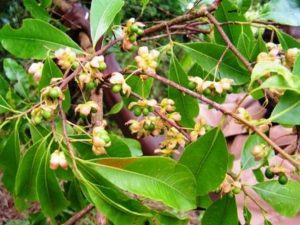
Ochna schweinfurthiana. Photo: Jos Stevens. Source: Flora of Zibabwe
The group came together to look at Ochna schweinfurthiana with its shiny green fruit topped by colourful red sepal ‘skirts’ swinging in bunches like Christmas tree ornaments. It is distinguishable from Ochna pulchra by the bark which does not flake in papery strips nor peel off the branches. We were to see many of these during the morning together with Ochna puberula with its somewhat smaller leaves.
An interesting encounter was with Monotes engleri which has green leaf tops but is silvery grey and hairy underneath. It is therefore distinct from the rather more brittle textured, shiny and bright green surfaces on both sides of Monotes glaber. We were fortunate to be able to compare these two growing so near to one another. We were also able to see the shiny dark brown gland at the base of the leaves of both species although an unusual feature on the M. glaber was the existence of glands on the under sides of some leaves.
It was a pleasure to be able to recognize Ficus thonningii several times during the morning, the roots usually interestingly entwined around rocks or lining cracks in rock formations and to see the mid rib which goes right to the end of the leaf. We also saw Ficus sur with its easily recognizable stipule and the scar which goes the whole way around the branch, the stipular was also pointed out.
A small diversion arose when a ‘sensitive’ plant was discovered in flower, tiny yellow and star like in appearance, and fun to watch it close in on itself when gently touched at the top. It was odd to see tree people in a head down position exclaiming with delight when one is accustomed to seeing them craning their necks upwards and sideways in efforts of identification.
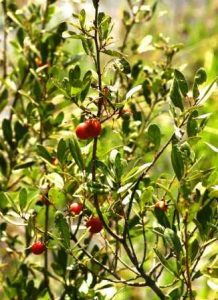
Diospyros lycioides. Photo: Petra Ballings. Source: Flora of Zimbabwe
Diospyros natalensis of the Ebony family became something of an old friend as it occurred fairly regularly along the way. It is called the tickey or money tree by some people with its round shiny dark leaves which I thought rather attractive. We also found Diospyros lycioides, sometimes known as monkey plum or red star apple with its narrowly obovate leaves and later on in the morning we were able to see yet another of the Ebony family in the shape of Euclea divinorum with its diamond shaped, sub-opposite leaves or occasionally alternate leaves having short petioles and also Euclea natalensis with leaves alternate, petiolate, leathery dark green above and lighter, usually short hairy beneath.
To the great delight of the children, and some adults too, a chameleon put in an appearance, and it was hard to drag oneself away from watching its ever-pleasurable habit of changing colour with its mood and in different light. A breather was taken at what appeared to be the crown of a kopje where we took refuge from the heat of the sun under towering rocks and revived in the shady coolth of the trees which Kim identified for us, running over their salient features to be filed away in our memories for future reference. A majestic Brachystegia glaucescens, mountain acacia, is worth of mention as was a Pappea capensis with its serrated leaves when young and entire margins when older, I was fascinated to learn that this was Lobengula’s indaba tree. We were shown the waxy under surface of the Maytenus undata which when rubbed exuded a musty smell which someone identified as reminiscent of dirty pantry shelves!
Moving on to our find of a particularly good specimen of Hymenodictyon floribundum in the lee of a huge rock which some of our hardier members shinned up, they were rewarded for their efforts of being able to look down on the attractive spiky yellow flowers with its paired red bracts at the base of each stalk of flowers. All RUBIACEAE have opposite leaves and interpetiolar stipules, but it was fantastic to see the little black ‘teeth’ ranged around Hymenodictyon’s stipules under the 20x lens.
Our return journey yielded brown flowering Brachystegia boehmii which I prefer to think of by its name of Prince of Wale feathers, and before we knew we were back in the beautiful garden surroundings of Entre Rios able to relax and eat lunch to the accompaniment of calls from the ‘go way’ bird and watch the antics of the Ground Scraper Thrush. It was good to have Chris and Ros alongside us on the walk and we thank them very much for providing such a worthwhile venue. We hope they enjoyed it as much as we did.
-Marjorie Barker
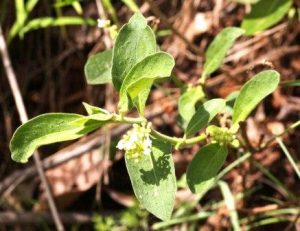
Psychotria kirkii. Photo: Bart Wursten. Source: Flora of Zimbabwe
The herbarium confirmed that the large, furry leaved Terminalia was T. mollis and the bush with bacterial nodules was Psychotria kirkii as we had thought, although few of us have seen it in the bush before. The 8m tall spindly trees amongst the rocks must have been the largest Tricalysia angolensis we have seen for quite a while, and the scrubby thicket of Catunaregam in full flower was quite a site!
After our picnic lunch in Chris and Ros Carter’s delightful garden, the party split into two groups, one group to go direct to the river to look at the riverine vegetation and the other group, who would join the first group later in the afternoon drove to the neighbouring farm to see Mr. Colin Wintle’s very interesting set up for breeding waterfowl. Alongside his farmhouse he has constructed ponds the surrounds of which are planted to grass reeds and shrubs for cover and nesting sites for the birds, the whole enclosed within a wire netting aviary to protect against predators. Some ducks are surface feeders and others are bottom feeders, so the water gets churned up and with all the duck droppings the water needs constant attention. All the ponds are flooded daily with clean water and emptied and cleaned periodically except where an ecological balance has been established between ducks, fish, algae and water plants, etc. Sword tail fish are bred for feeding fish eating duck, while the other ducks are fed on high energy layers pellets and lettuce etc. from the large vegetable garden adjacent to the ponds, grown especially for the ducks though a little is allowed into the household kitchen! In most of the ponds only water lettuce survives, water lilies having no chance as they are gobbled up by the ducks, except for the large ecologically stable pond where indigenous Pygmy geese breed successfully and enjoy the good growth of water lilies which they find necessary. Another local duck breeding successfully is the White backed Duck. One of these females was sitting on 9 eggs, surprisingly large eggs for the size of the bird, and she attacked Mr. Wintle viciously when he disturbed her to show us the eggs. However, Mr. Wintle seemed immune to her nasty beak, maybe he is used to it by now since she has been breeding for 8 years, with an average of 4 broods per year for the last 5 years. From 152 eggs she has raised 77 ducklings.
One male Striped Crake was walking round a pond, possibly waiting while his “wife” laid her clutch of eggs which he would then take over and incubate. Her 2nd husband was already incubating her previous clutch of eggs for her.
Our local duck scene included our two commonest residents, namely Red-billed Teal and Pochards. Also, Hottentot Teal, Cape Shoveler, Maccoa and Fulvous Whistling Tree duck. The latter we were told has the widest world distribution of all duck.
On then to the “exotic”, non-indigenous ducks of which there were many, including Carolina Wood duck, American; tufted Duck, a common European diving duck; Argentinian Teal, Ruddy Duck, N. American, Hooded Merganser, American, the beautiful Mandarin duck, China and the Golden Eye which swims between the icebergs on the St. Lawrence in North America and yet has settled happily here in Central Africa. These birds were raised here from eggs sent by Peter Scott from his famous Wildfowl Reserve at Slimbridge, England. Here because of the changes, the birds “jump a year” and breed a year earlier than they would have done in Europe. A pair of Ringed Teal from South America were swimming in the pond followed by their baby. In their natural habitat these Ringed Teal nest in a tree.
Broody Bantam hens are used to incubate many of the eggs sent from Slimbridge and elsewhere and in the “nursery cage” a patient Bantam mother waited while her brood of Carolina Wood duck ducklings took off into the water and swam away from her, apparently used to this odd behaviour from her offspring.
Altogether Mr. Wintle has 19 species of Waterfowl some of which are already 8 years old, though he has only been on his present farm for 2 years.
How rewarding it was to meet such an enthusiastic and dedicated naturalist and we thank Mr. Colin Wintle most sincerely for showing us round his most interesting breeding ponds and explaining to us his preservation of Wildfowl and exchange of eggs worldwide for breeding purposes. Well done, Colin.
-Sybil Duncanson
We left far too little time, in the afternoon, to steep ourselves in the wild beauty of the river on the eastern boundary of the farm. The Nyambuya river flowing quietly behind a belt of typical sandveld trees, which could justifiably claim the classification of Monotes – Burkea woodland, suddenly and dramatically revealed itself as an artist’s dream of huge water worn boulders piled in breathless profusion. Their sites and bases were bestrewn with masses of smaller boulders of infinite shape and water crafted design; the whole shaded here and there by stem fruit trees, Bequaertiodendron magalismontanum and Sesbania, indigenous willows, Salix subserrata and water berries, Syzygium cordatum.
Truth to tell, the Bequaertiodendron looked rather wan because of the warmth of the day but they were impressively healthy and needed only a shower or two to spread their leaves with joy. The emphasis is Bequaertiodendron is prompted not only by their marked profusion, but also by the marvel of their adaptability. Several years ago, Denzil Carr, past President of the South African Tree Society and currently Editor of its Journal, reminded us of the origin of the type specimen from the Magaliesberg Range, and expressed his delight at finding it so perfectly adapted to riverine conditions here.
In our slow crossing over the boulder-strewn river with water gurgling below to remind us that this was not merely a rock scrambling expedition but a privileged passage over an important water source. The river supplies Marondera, several miles southeast with its water needs. We paused often to admire mosses and ferns and near the far bank, fascinating root patterns etched on the surface of those boulders too dry at the moment to sustain the greenery of the water plants themselves.
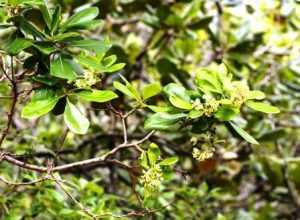
Pittosporum viridiflorum. Photo: Bart Wursten. Source: Flora of Zimbabwe
Figs, more particularly Ficus thonningii, and river combretums, Combretum erythrophyllum, Pittosporum viridiflorum and the red star apple Diospyros lycioides, also adorned the river course. On the steep rising bank on the far side were other river combretums, figs and Syzygiums, with Rhus longipes, Maytenus undata and Carissa edulis also claiming their rightful place in that environment. The massed small, round, dark leaves of Diospyros natalensis, and the graceful undulations of Euclea divinorum foliage added more contrast of colour, shade and shape. We had no time to savour the abrupt rise from the riverine to kopje vegetation, but the angular stems of Grewia flavescens were plentiful on the lower reaches. Pterocarpus rotundifolius had come down to meet us and so had Dombeya rotundifolia.
I wondered whether Dombeya kirkii could have been there. Probably not, at 4800 feet, although lower down in that river system, D. kirkii occurs on the Mazowe. The Nyambuya on which we were luxuriating, joins the Chinyika lower down, and flows into the Nyagui. This in turn, after its junction with the Shavanhovhve, flows into the Mazowe.
While on the far bank, a mere 50 meters of which we were able to amble over in the time available, we were charmed by some rock art “Bushman paintings” and were intrigued by the flipper-shaped feet, or footwear, of one group of figures. They looked for all the world like the rubber or plastic flippers of the modern snorkel diver or spear fishermen. There were however no arrows or spear guns visible, and that probably accounts for the survival of the eel like fish spotted by Lola Irvine in one of the pools.
The lower section of the primitive paintings was noticeably fainter than the upper half. That river must come down in torrents at times, which could conceivably be the explanation, I suppose, of the faded lower paintings. Alluvial deposits and moss like plants were evident high up the bank.
The rock overhang itself had exceptional charm, apart from its paintings. A fig had taken root under it and had sent up a substantial trunk which, on reaching the overhang, had spread out strong leafing and fruiting lateral arms as if to support the massive weight of the overhang.
Our expedition was little more than a recce because of the time spent in crossing over the boulders and looking into the nooks and crannies. On our return we found Meg and party about to begin their exploration after 4pm. We hope they have returned by now, this being the Thursday following the Sunday in question especially as Meg seemed determined to carry her tiny grandson over the rocky cauldron to study riverine vegetation at close quarters.
-R.W.Petheram
NOTE ADDED IN PROOF: The promised fig key has been run off, but still suffers from a few hiccups. I think it will be better to correct these before the next month.
K.ST.J.D.
-KIM DAMSTRA, Acting Chairman


